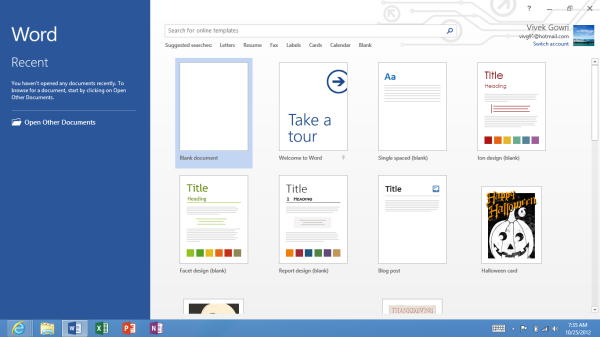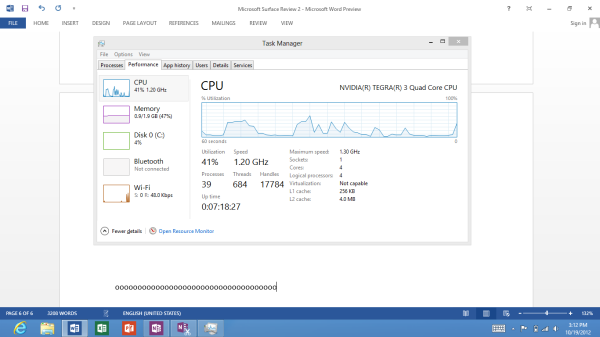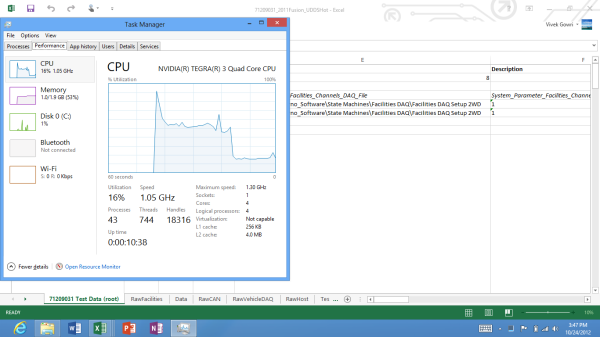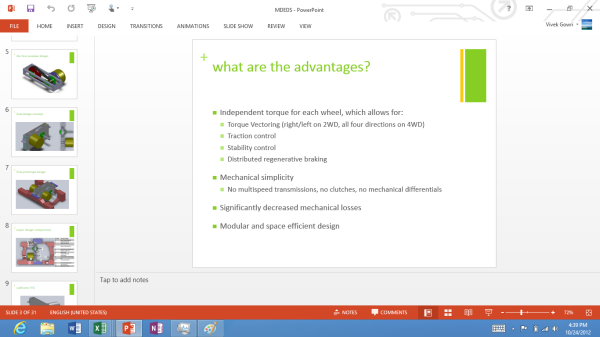The Windows RT Review
by Vivek Gowri & Anand Lal Shimpi on October 25, 2012 12:00 PM EST- Posted in
- Windows RT
- Operating Systems
- Microsoft
- Mobile
- Windows 8
- Tablets
Office 2013 for Windows RT
Office 2013 is the headlining application for Windows RT. And it’s a pretty big deal - this is the first time we’re seeing the full Office experience reach a modern tablet platform, at least in the first party sense. In the smartphone world, this wasn’t as much of a distinguishing factor as Microsoft hoped it would be when they included a mobile version of the full Office suite in Windows Phone 7, but that’s because there’s relatively little scope for document creation or editing on handhelds. In the tablet world though, it’s huge. For a tablet to truly be a viable replacement for a notebook, office productivity needed to be addressed.
So Microsoft decided to do something about it: Office 2013 Home and Student Edition ships as a pre-installed part of every single Windows RT tablet. And just like that, almost every non-engineering student I know could get away with a Windows RT tablet as their primary computing device, provided they aren’t gamers or aren’t attached to the idea of local storage. It’s something I couldn’t say about the iPad or any of the Android tablets out there. But I’m getting ahead of myself here. Let’s look at the applications themselves.
Office Home and Student contains Word, Excel, PowerPoint, and OneNote, so you get the core three productivity applications, as well as the one with the most potential for tablets. The one application that will probably be missed most is Outlook, but with Outlook account support for both the Mail and Calendar apps, enough of the functionality is still available. Outlook is more power-user oriented than either Mail or Calendar, but when it comes down to it, Windows RT was created to serve a more consumer-oriented market segment that typically doesn’t rely on the more intricate functionality of Outlook.
Design was always the biggest question about creating a mobile office suite. How much would Microsoft be willing to change the interface to suit a touchscreen input? How much functionality would that give up? How would Excel even work? I don’t actually have an answer, but here’s where the thinking went: why bother designing a touch-centric typing or spreadsheet app if most people are going to turn to a physical keyboard to use it anyways? And it’s a line of reasoning that makes sense - beyond going completely to voice control, I cannot see myself using any word processor without touching a physical keyboard. And many of the more complex functions of Excel, like formulas and macros, would be near impossible to replicate on a touch-centric UI without neutering a decent amount of the power and control users have.
So, instead of redesigning Office to fit within the new Modern UI guidelines, Microsoft simply ported the x86 version of Office 2013 over to ARM and runs it as a desktop application. I can’t blame them - Office 2013 was redesigned with the Metro design language, so it already fit the Windows RT visual style, and it was just easier for them to not mess with the UI or UX further. But that’s actually a good thing - Office is the killer application for RT because it functions exactly the same as Office 2013 on any other system. If you live in the world of Office 2013 and SkyDrive, this is fantastic news because you need to make almost no adjustments to your workflow. It’s just as capable and powerful on here as it is on any other Windows system.
Office isn’t perfect, and you can level any number of complaints at it - aggravating at times, uses proprietary file formats, resource intensive, expensive, difficult to learn, and I’m only scratching the surface. Based on my usage of the Office 2013 Preview on Windows 7 and RT, it’s actually my favorite version yet, so there’s that, but the main point is that this is still a full-fledged version of Office that we’re talking about here. Over the last two decades, people have learned to put up with its quirks and faults, and it’s still one of the single most important pieces of productivity software on the market.
So, how does it all work? Pretty well, all things considered. All of these applications are pretty much exactly as you would find on an x86 PC, so I’m not going to go very far into the design and functionality, though there are a couple of interesting use-cases that I’ll bring up later on. The most critical concern I had going into Office on ARM was performance - the reputation for being a resource-intensive software suite is not undeserved, let’s put it that way, and quad-core A9, great as it is, doesn’t have the raw compute horsepower of Atom much less Core 2 or any newer Intel processor.
In Word, it’s relatively easy to pull 30% CPU utilization when typing quickly. Anand saw up to 40% on Surface, and I managed to get CPU utilization all the way up to 55% when pressing random keys as quickly as possible. Compare this to Notepad, which usually hovers in the 5-10% CPU utilization range, and it’s clear to see how heavy a load Office puts on the system. Even with the high CPU utilization though, I never saw any lag in the characters appearing, so it’s mostly an interesting point to note and not an issue with the typing experience.
Update: Microsoft shared an official response with us about the high CPU utilization we're seeing:
Increases in CPU utilization while typing are an expected behavior in Word, but should not extend beyond the immediate typing. However, we are always looking at ways to improve CPU utilization and the customer experience with Office.
To really push the system, I loaded up some of the Excel files I work with at my real life job as an automotive technology researcher. These are raw and mostly unprocessed dynamometer data test files, with roughly 3 million data cells each (give or take.) The largest had just under 4 million data cells and was 39MB in size, smallest about 1.8 million and 19MB in size. A couple of graphs and some equations. Together, the four files totaled 112MB. I decided to open all four at once - it took about a minute and a half, with a max CPU load of 72%. It was crazy, but once everything was loaded, performance was actually decent. I wouldn’t want to necessarily work on the files for extended periods with a system like this - the screen is too small, and the couple of bits of lag would drive me nuts (plus, without Matlab, it’s a bit pointless) but for quick graphing of basic data, it works significantly better than expected.
The good thing is that there’s a lot of RAM here - with 2GB seeming to be the default for Windows RT tablets you’re rarely memory starved. So even with 250MB worth of RAM dedicated to Excel, CPU headroom is still the main limiting factor. For more basic Excel tasks, like the chemistry labs that were commonly assigned in undergrad, there’s definitely more than enough power here. The files I loaded up are typically only manipulated on quad-core workstation notebooks and are far and away an extreme use case.
I didn’t really spend a whole lot of time in PowerPoint, because I typically don’t use it very much. I loaded up a presentation I gave late last year about some of my research at the time, and started editing it to see if the experience had anything different to mention. Performance seemed good enough, with maybe a hint of frame drop when scrolling through the slide thumbnails on the right edge (it moves at something closer to 25 FPS than 30). I liked the ability to swipe back and forth between slides when in Presentation mode, that’s one nice thing about the tablet interface. Other than that, this is just PowerPoint on a smaller screen.
OneNote is the one that I was really interested in. Because even though it runs within the framework of the Windows desktop, it’s an application that really lends itself to tablet usage. Back in the tablet PC days, OneNote was the killer usecase, the one program that really lent itself to being used in conjunction with pen-input. I came very close to buying a Wacom-enabled tablet on numerous occasions for the specific purpose of taking electronic lecture notes with OneNote. (It never happened, and I ended up taking very few notes of any kind through college, but such is life.)
Now, without active digitizer support on most Windows RT tablets (I haven’t seen any with active digitizers), you’re limited to either keyboard or capacitive touch input. This is where the handwriting panel comes in, and like I mentioned before, it’s quite good even when you’re just using your finger to write. With a capacitive stylus (which I regrettably do not have on hand) I can see this being legitimately useful to take handwritten notes on. It’s good enough that you can get away without a Wacom-enabled tablet if you don’t want to shell out the extra $400 or so. I genuinely wish something like this was available when I was still in the notetaking phase of college, many moons ago - the fifteen year old me would have killed to have a $600 tablet with solid handwriting recognition, even without an active digitizer.
And that’s really what makes Office for Windows RT interesting. It gives you 95% of the office suite experience and capability of any normal desktop or notebook PC in the modern tablet form factor, introducing some much needed productivity into what was previously a very content-consumption oriented device category.















233 Comments
View All Comments
Sivar - Thursday, October 25, 2012 - link
Vivek and Anand, did you experience the problems described by guidryp?cappasay - Thursday, October 25, 2012 - link
I may be wrong but from what I understand, all the crashes are about third-party apps forcefully closing down. Not native apps, and not a full system crash or anything like that. Presumably that will get better over time, as devs actually learn the platform (updates are getting pushed out daily). Slowdowns seem to have occurred in other videos, only you have a bunch of apps open at the same time.daboochmeister - Thursday, October 25, 2012 - link
Not according to other reviews. E.g. Matt Burns at TechCrunch, whose review reads as completely honest and informed, found crashes in the Metro^h^h^h^hodern apps, at least once per app, including MS's. And he found the new IE10 to be less than great.http://techcrunch.com/2012/10/23/microsoft-surface...
Other reviews have said much the same.
The more high-profile the site, the more likely they are to give it a positive review. Hmm ...
VivekGowri - Thursday, October 25, 2012 - link
For the record, I had exactly one random shutdown, and that was when I was switching between two different camera applications at the same time. It seemed forgivable, and other than that I legitimately had no major bugs/crashes when I was testing. My VivoTab RT was really solid from a software standpoint, I don't know what to tell you guys.daboochmeister - Thursday, October 25, 2012 - link
Hmm. Maybe the Surface RT then. Different hardware.PeteH - Thursday, October 25, 2012 - link
Just because some people run into bugs it doesn't mean everyone will.p05esto - Thursday, October 25, 2012 - link
Lame response. Have you personally found all of these bugs and problems you are posting about? Do you have a Windows tablet in your hands? Just curious. In other words you are a fool, lol.TEAMSWITCHER - Thursday, October 25, 2012 - link
I too, am finding myself a bit suspicious of these reviews. I just cant get excited about Windows 8...in any form. There is something about it that disgusts me. Let me try to explain......Windows 8 was not designed to solve problems for me. It was designed to solve problems for Microsoft - namely competing against Apple mobile devices and Google's web services. The only major new functionality is a UI that can driven by a touch screen - (Compete with Apple) and the new Start Screen which is huge billboard directing witless users to Microsoft Web services (Compete with Google.) What does Windows 8 do for me, the guy who runs Windows 7 on a single 27" monitor with a Mouse and Keyboard?
Many people have told me that the tiles will be great. Really? I think that Gadgets are better, as I don't need to leave my desktop for a simple status update! That Metro apps will be great - you can run two apps side-by-side. I can run many apps side-by-side in Windows 7. I have read that touch screen laptops will transform the Windows experience. Not for me, I don't want to look through a hundred finger smudges to see my work.
The UI is definitely NOT gorgeous! The overuse of inky pastel colors makes me cringe every time I look at it. The removal of glass Windows and drop shadows make the desktop look old, flat, and boring. Please don't give me the "Simple and Elegant" argument - its not that!
I fear that all my ranting is for naught. No matter what I say, type, or do it won't matter. Windows 8 will be a resounding success because there is simply nothing else the PC OEMs have to sell. Microsoft will no doubt take the stage at this fall's BUILD conference and proclaim that they were right.
Sadly for me I cannot agree. Windows 8 is where I and Microsoft part ways...forever! I'd like to think that the break up was amiable, but that's not what happened.
Microsoft tried to F@#K me!
steven75 - Friday, November 2, 2012 - link
It's also almost like Vivek is completely unaware of the iWork suite that came out with the iPad back in 2010. And it's completely touch-optimized, not just a ported hack from OS X.code65536 - Thursday, October 25, 2012 - link
So how exactly is this no-third-party-desktop-apps thing enforced? Are they simply relying on the fact that people haven't recompiled EXEs from Intel to ARM (no enforcement)? Are they restricting the availability of the compiler (but they need a native compiler for folks like driver developers)? Are they whitelisting EXEs? Or must EXEs have a certain digital signature before they are allowed to run?